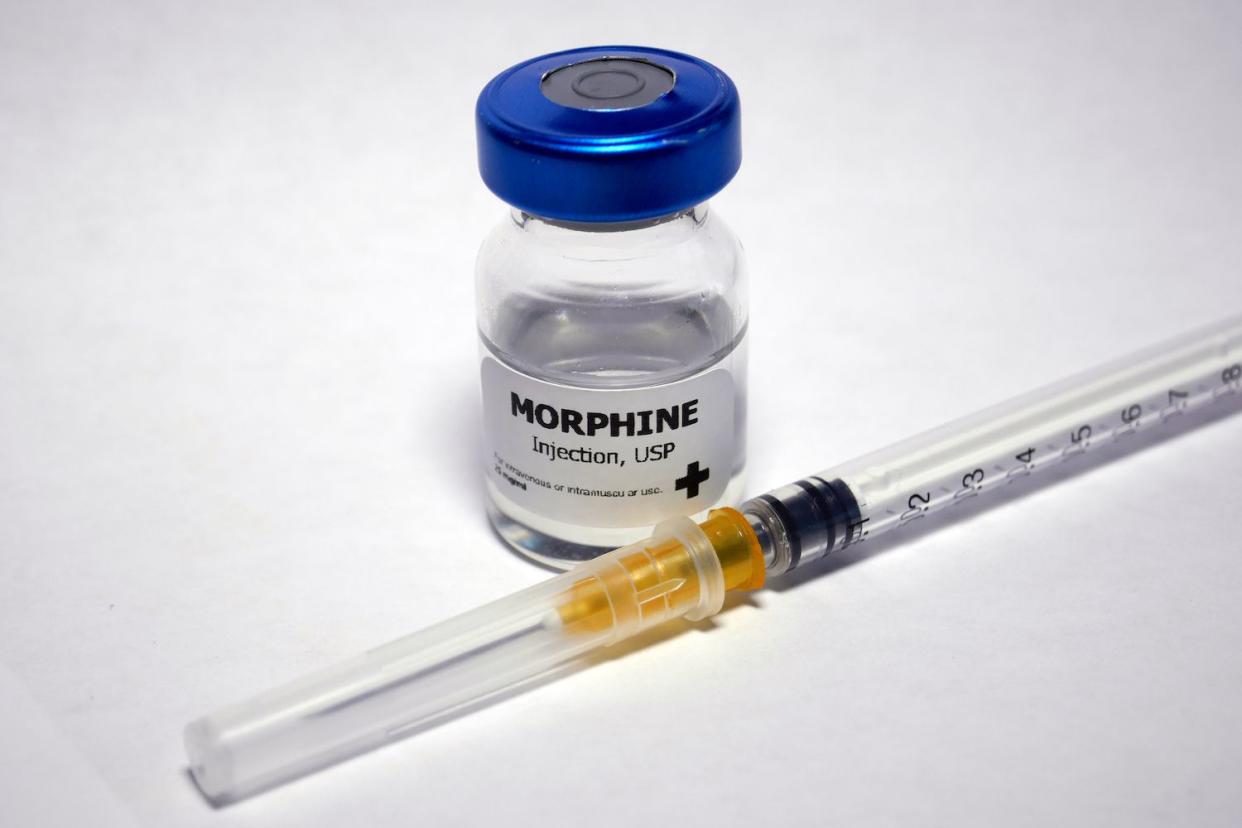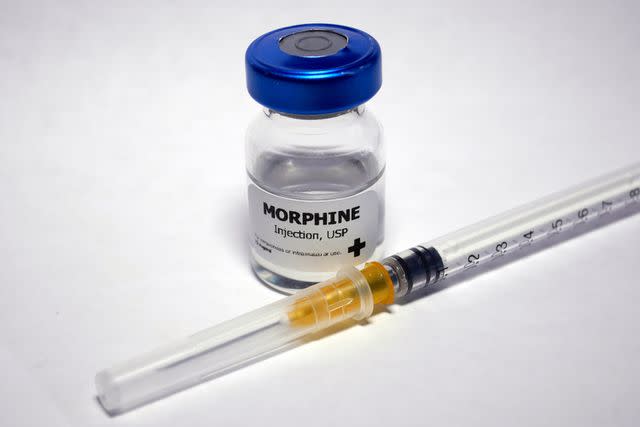Pain Relief From Dilaudid vs. Morphine

Hailshadow / Getty Images
Medically reviewed by Kristie Reed, PharmD
Dilaudid (hydromorphone) and morphine are two of many opioid medication (previously called narcotics) that healthcare providers may prescribe to people in moderate to severe pain. They work on the opioid receptors of the body to reduce pain and may also cause a euphoria, commonly called a "high."
While similar in many ways, these two medications are different substances. Morphine is a naturally occurring opioid processed from poppy plants. Dilaudid is a semisynthetic medication, a derivative of morphine, made in a lab.
This article compares Dilaudid and morphine in terms of strength, side effects, the potential for abuse, and more.

Hailshadow / Getty Images
What’s More Powerful, Morphine or Dilaudid?
For the same amount of medication (dose), Dilaudid will have a more substantial pain-relieving effect than morphine. The opioid oral morphine milligram equivalent (MME) from morphine to Dilaudid is 4, meaning Dilaudid is about 4 times as strong as morphine.
The MME metric is used to monitor the overdose potential of opioids. However, the effectiveness of any pain medication can be influenced by:
Type of pain being treated (acute, cancer-related, chronic, neurologic, or end-of-life)
Medication forms (oral and intravenous are very common)
Perception of pain (including behavioral, cultural, emotional, and psychologic factors)
Bioavailability
Bioavailability is the amount of drug that reaches the bloodstream after it is taken. For example, a medication that is administered intravenously (IV, within a vein) has 100% bioavailability because it is injected directly into the bloodstream. A medication that is taken by mouth releases much less of the drug into the bloodstream because some of the medication is lost in the stomach and intestines and takes time to finally get into the bloodstream.
Other factors affecting bioavailability include:
Route/site of administration: This is the way the drug enters the body.
Clearance of the drug: This is how fast the body metabolizes it.
Distribution: Some drugs must bind to fat or proteins to travel the body, while others dissolve in body fluids.
Interactions: Some drugs may interact with other medications in the body.
Oral medications: The amount of food in your stomach, the timing of medicine, and other factors can influence how much drug is available.
Your healthcare team will assess your pain before, during, and after treatment. It is normal to adjust pain medications, doses, and timing to find a process that helps your pain.
Dilaudid vs. Morphine: When They’re Administered
Both Dilaudid and morphine are meant to be prescribed for the treatment of moderate to severe pain. In the past, morphine was a commonly used pain medication.
However, one study demonstrates that Dilaudid is used more often now for medical and surgical pain. Specifically, Dilaudid use increased by 17% for chronic pain patients and 22% for surgical patients when compared to morphine use.
Because of the high potential for abuse and the strong side effects of these medications, they are available only with a prescription from a healthcare provider. Dilaudid is generally reserved for people who have tried other, milder medications and still have pain, as well as for those with chronic, long-term pain.
Before dispensing a prescription, your provider will ask questions about your pain location and type, and the treatments you have already tried. Typically, opioids are used for short-term treatments of acute pain.
Side Effects
The side effects of Dilaudid and morphine are very similar. Opioids activate receptors in the central nervous system (brain and spinal cord) and throughout the body. Side effects vary but may include:
Confusion
Drowsiness or sedation
Mood changes
Nausea
Slowed breathing
Low blood pressure
Heart rate changes
While the general side effects are similar, Dilaudid has a higher potential for sedation, a shorter half-life, and a higher potential for abuse. Overdose of opioids can lead to death.
Drug Forms
Dilaudid and morphine can be prescribed as a suppository, tablet, capsule, or liquid to take orally. It can also be given by injection in a vein (IV), muscle (IM), or under the skin (subcutaneous or SQ).
Both medications also have immediate-release and extended-release formulas available. Extended-release formulas of these medications are usually for people with chronic (long-term) pain. Your healthcare provider will determine which drug, dose, route, and type for you to use.
Potential for Abuse
Dilaudid and morphine are controlled substances with a high potential for abuse and addiction. Concerns about misuse of pain medications like Dilaudid and morphine have led the healthcare community to raise concerns about the opioid crisis, sometimes called the opioid epidemic.
Due to the euphoria that opioids create, there is a high potential for medication misuse. Some people take these medications in higher doses or more frequently than prescribed. Other people buy or sell these medications without a prescription from a healthcare provider.
Understanding the difference between abuse, dependency, and addiction is important, They entail:
Abuse is when medication is taken at a higher dose or more often than is prescribed. Mixing medications (for example, opioids and alcohol) can also be a form of abuse.
Dependency is when the body adapts to regular exposure to the medication, and withdrawal symptoms occur if the next dose is delayed or skipped.
Addiction is a physical and psychological dependence on a substance in which a person constantly and compulsively seeks the next dose.
Learn More:How to Recognize and Treat Opioid Abuse Before It’s Too Late
High doses of drugs or using drugs obtained by unsafe manufacturing processes can lead to respiratory depression, cardiac arrest, and death. Narcan (naloxone) can be a lifesaving treatment for a known or suspected opioid overdose. In March 2023, the FDA approved Narcan Nasal Spray in March 2023 as an over-the-counter (OTC) emergency treatment for opioid overdose.
Summary
Dilaudid and morphine are opioid medications for short-term treatment of moderate to severe pain. They are similar but different medications. Dilaudid is four times stronger at the same dose.
While both are effective for pain, both drugs also can have uncomfortable to life-threatening side effects and a significant potential for abuse. Speak with your healthcare provider about any concerns regarding your pain or pain management plan, and be sure you understand how to safely use any medications you have been prescribed.
Frequently Asked Questions
What are the strongest pain relievers?
Opioid medications are very effective pain relievers. They work mainly on the brain and spinal cord to reduce pain signals from the body. They do not fix the source of the pain but help you tolerate it.
What makes Dilaudid stronger than morphine?
Dilaudid is considered to have a higher analgesic potency than morphine. Dilaudid provides more pain relief with a small dosage. However, the exact mechanism of strength or potency of any medication for one person is not fully understood. Your healthcare team will work with you to develop a pain management plan.

